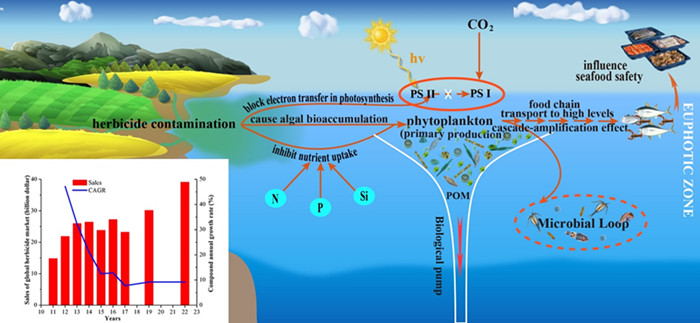
With the rapid growth of global population and food demand, herbicides are being excessively used worldwide. More than half of the herbicides in market are photosynthetic inhibitors, which can cause serious negative effects on photosynthetic organisms at high concentrations.
Scientists speculate that a large amount of herbicide residue will eventually enter the ocean via groundwater or surface run-off every year. However, we know little about the global coastal pollution status of herbicides and their negative impact on marine life.

Fig. 1: Global trends in herbicide market sales and its potential impacts on coastal ecosystem through their toxic effects on phytoplankton. (Image by YANG Liqiang)
Recently, a research team led by Prof. ZHANG Yongyu from the Qingdao Institute of Bioenergy and Bioprocess Technology (QIBEBT) of the Chinese Academy of Sciences (CAS), for the first time on a large spatial scale, systematically surveyed the distribution of ten widely used triazine herbicides in the Bohai Sea and the Yellow Sea (Fig. 1).
The results showed that the pollution status of herbicides in coastal waters reached a degree that could not be ignored. For example, the total concentrations of the ten triazine herbicides at certain station reached as high as 6.61 nmol L-1.
They transferred the toxicity of all the ten herbicides into atrazine toxicity equivalents and revealed that the ten triazine herbicides at environmental concentrations could jointly inhibit the growth of algal cells, the maximum quantum efficiency of photosystem II (Fv/Fm), and the algal nutrient absorption.
Transcriptome analysis revealed that multiple metabolic pathways related with photosynthesis and carbon metabolism was greatly disturbed, which might be able to ultimately influence the primary productivity of coastal ocean.
Furthermore, since the algae could highly absorb and accumulate atrazine inside the cell, herbicide pollution might affect the organisms at higher levels by transfer in food chain and even threaten the seafood safety of human beings.
The scientists indicated that herbicides were becoming a new threat to the ecological functions of marine ecosystems. The situation might become more severe with the increase of herbicide application. Thus, there is an urgent need to clarify the distribution and fate of herbicides in global coastal waters, and most importantly, uncover their current threats to marine ecosystems.
The study was recently published in Environment International, and it was supported by the National Key Research and Development Program of China, the National Natural Science Foundation of China, the Senior User Project of RV KEXUE etc.

86-10-68597521 (day)
86-10-68597289 (night)

86-10-68511095 (day)
86-10-68512458 (night)

cas_en@cas.cn

52 Sanlihe Rd., Xicheng District,
Beijing, China (100864)

